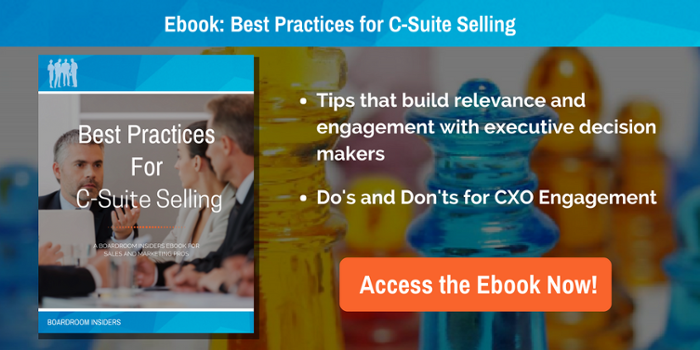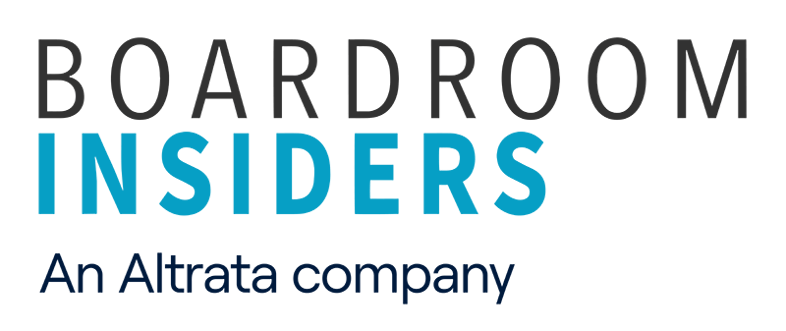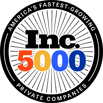
Day in and day out we conduct deep research on the c-suite so you don’t have to. We look for CXO insight that helps sales and marketing teams better understand their prospects and customers—what they’re thinking, their goals, challenges and what keeps them up at night. We also seek out nuggets that reveal something about their personality and key quotes that strike at the heart of what they and their organization are all about. When it comes to selling to CXOs, knowledge is power. The more you know, the better you can position yourself as being relevant, credible and a worthy potential business partner.
But, as you might guess, not all CXOs put themselves out there, publicly. So we get especially excited when we uncover a particularly insightful interview, or an executive who authentically uses social media, or has an active blog, and leverages these opportunities to articulate a point of view. When we can package all of this insight—along with information from other sources, like earnings call transcripts—into one of our profiles, we know that our customers are getting an invaluable tool.
But a tool is just a tool. To get real value from it, you have to know how to use it. And we can help with that, too. We often counsel our customers how to use the insight contained within Boardroom Insiders profiles, both through individual consulting arrangements as well as through the numerous tips and best practices articles contained within our blog.
By way of example, we are sharing some insight from five of our CXO profiles, including key executive quotes, to show how you might connect the dots to your business to create a relationship-building or revenue opportunity.
Editor's note: Due to the fast changing pace of business the following information may no longer pertain to the corresponding C-level executive. However, it is still relevant when understanding how to apply CXO insight to business conversations.
.png?width=320&name=01.%20Michael%20Bayley,%20President%20and%20CEO%20of%20Royal%20Caribbean%20International%20(1).png)
Michael Bayley, President and CEO of Royal Caribbean International
What he said:
"Technology," said Bayley, is “the DNA of Royal Caribbean. It’s all part of the innovation journey, which has been part of what we’ve done for many years in terms of how we design and bring product to market. The Quantum Class was another step forward with innovation, but there was a lot of focus on technology and innovation. That also speaks about this move to be more digital in terms of how we’re looked at in the marketplace. Certainly, the connectivity piece, which is really quite radical in terms of being able to just be like you are at home with streaming and digital and whatnot is a big part of it.”
What you can do with it:
Shamelessly quote Bayley directly in your communications with him, his direct reports, or any other contact you are targeting within the organization. Tell them that your solution directly supports this focus and provide a few brief and specific bullets outlining exactly how. Better yet, if you have worked with any other companies in his industry, cite that too, which adds to your credibility and relevance. Connecting the dots clearly for them between what they are trying to accomplish and what you bring to the table shows that you have done your homework and obligates them to have a conversation with you to learn more.
.png?width=320&name=02.%20Owen%20Mahoney%20President%20and%20CEO,%20NEXON%20Co%20(1).png)
Owen Mahoney, President and CEO, NEXON Co.
What he said:
The online and mobile gaming chief talked about the potential for the games industry, saying, “There’s going to be new technologies, there’s going to be mobile, a lot more power, Moore’s Law affects the games industry like every other industry. The thing about exponential growth is it starts off and you don’t even notice it, and then it goes vertical, and that will affect the games industry. So there’s a lot to like there. Where is it really at? Services. These incredible experiences that you can create, that are essentially sociological and economic experiments, that are so cool. All good online games have an aspect of that, and that’s where the real fun is, in my view.”
What you can do with it:Mahoney is clearly open to looking at emerging technologies and how they can change the game, so to speak, with new business models and services. Consider how the technologies you offer can help his company create the incredible experiences he’s seeking to give his customers. How can you bring services to online gaming? Read more and you’ll find he’s trying to battle commoditization and loves the “artistry” in gaming. Use his own words to set the stage for a meaningful conversation about the gaming industry’s future and how you can help him innovate in game-changing ways.
Download our free ebook, Best Practices for C-Suite Selling.
Dr. David Bensema, CIO, Baptist Health System
What he said:
“I live the true IT life. Most things come by surprise. When I took on the CMIO role I was being brought on because obviously Meaningful Use was becoming an increasingly heavy lift. I was asked to help with physician engagement and with development of additional order sets and I-forms within our existing EHR to help our hospitals achieve Meaningful Use targets, and so I came in with that in mind. One month later, our CIO left the position and we had an interim appointed. A month after that we’d had a review from an outside consulting group and they pointed out what was obvious, which was that we needed to get on a unified system. We needed to get away from the incredible disparity that we had in our system, and we needed a partner that was going to be able to grow with us.”
What you can do with it:
You haven’t even met him, but already you know that Bensema is ready to deal with surprises and has expertise in physician engagement and Meaningful Use. He’s deeply engaged in developing a unified system and looks for partners with business and industry acumen that can grow with their organization. By speaking to your own industry expertise and partner mindset—using real customer examples—you can position yourself to have a real business conversation about how you can help him solve the IT issues still outstanding as they move forward.
Shawn Purvis, VP and CIO, Northrup Grumman Corporation
What she said:
“I learned the characteristics of leadership from my parents. Both my parents worked at IBM, and they encouraged me to pursue my studies in technology and my mother in particular provided a phenomenal role model for me and continues to have profound influence on my life. I have found there are few role models for women and minorities in information technology. It challenged me to do my best every day; there are no second chances at a first impression...I have learned to remain flexible yet disciplined, to be accountable to my team, to lead with passion and to be a champion for diversity. I enjoy the challenge of developing technical solutions that save the lives of the men and women who have dedicated them to protecting this great country.”
What you can do with it:
Purvis has generational roots in technology that you can tap into. For example, is there an executive at your company who has deep, multi-decade roots at IBM who could serve as executive sponsor? She doesn’t see many role models for women or minorities in IT. Does your company have a senior executive who is equally passionate about these issues? Do you run an event or sponsor some kind of STEM program targeting women to which you could invite her? She also has strong feelings about how her work connects to the success of the military. If your organization also does work that supports the military you can weave that into your presentation and conversation.
.png?width=320&name=05.%20James%20Routh,%20Chief%20Security%20Officer,%20Aetna%20(1).png) James Routh, Chief Security Officer, Aetna
James Routh, Chief Security Officer, Aetna
What he said:
Instead of viewing cybersecurity as primarily a tech problem that needs to be fixed, Routh’s approach is that it’s just one more business risk that needs to be managed, like fluctuating currency prices or the threat of lawsuits. According to a 2015 interview with the CIO Journal, each day, Routh looks at the cybersecurity threats facing the health insurer and how they’ve changed in the last 24 hours. He also looks at changes in Aetna’s ecosystem. He translates that information into a daily risk score and distributes it to company leaders. Understanding that risk is essential to making long and short term decisions on the allocation of scarce resources to the highest risks, he said. “We’re transparent about the risks to pretty much anyone inside the company because knowing the risk is the first step towards mitigating and managing that risk long term,” he said, adding that his team looks at threat information from thousands of sources, subscribes to three threat intelligence services and is a member of two information sharing and analysis centers for financial services and health care. Every day his team meets to talk about new security threats and to interpret what it means for Aetna’s risk. “Because we measure every day, we know what it is and when it changes,” he added.
What you can do with it:
You now have a blueprint of how Routh operates from a IT security risk management perspective. As a vendor, you can speak to his concerns, acknowledging the specifics of his daily strategy. How many people do you think will have taken the time to learn that he has a defined daily process for his team—and a daily meeting—to look at various categories of the company’s security controls?
The above five examples provide just a taste of the rich insight contained within our database—as well as suggestions for how you can use this type of insight to create closer customer relationships and more revenue opportunities. Boardroom Insiders collects this level of insight on thousands or enterprise CXOs. When you have this kind of rich information there’s no excuse for not being able to have a meaningful business conversations with CXOs.



.png?width=320&name=03.%20Dr.%20David%20Bensema,%20CIO,%20Baptist%20Health%20System%20(1).png)
.png?width=320&name=04.%20Shawn%20Purvis,%20VP%20and%20CIO,%20Northrup%20Grumman%20Corporation%20(1).png)




Share Your Thoughts